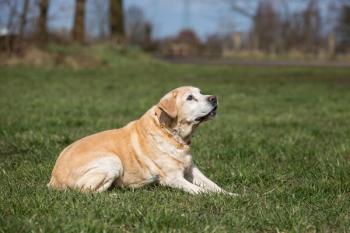
- dvm360 July-August 2025
- Volume 56
- Issue 4
- Pages: 22
Medical management of canine upper airway diseases

Managing upper airway diseases in dogs requires making an accurate diagnosis and targeted treatment.
There are several common upper airway diseases seen in canine patients. Each disease has different characteristics and requires a different approach to treatment. In a session at the 2025 Fetch dvm360® Conference in Charlotte, North Carolina, Christopher G. Byers, DVM, DACVECC, DACVIM (SAIM), CVJ, a practitioner in Omaha, Nebraska, and founder and editor of CriticalCareDVM.com, shared tips on diagnosis and management of common upper respiratory tract disorders in canine patients.1
Brachycephalic Obstructive Airway Syndrome (BOAS)
Brachycephalic dogs are anatomically predisposed to respiratory disease because of their stenotic nares and elongated soft palate. The changes in airway pressures can lead to everted saccules, gastroesophageal reflux disease, hiatal hernias, and, in end-stage disease, laryngeal collapse. Byers recommended that veterinarians “intervene as much as the owner will allow [as soon as possible]” to avoid progression of disease.
A strong suspicion of BOAS can be gained based on signalment, history, and physical examination. Dogs with this syndrome will often present with stertor and/or stridor and visibly stenotic nares. Approximately 25% of these dogs will also have a history of chronic retching, gagging, or vomiting.1 “If you see a brachycephalic patient presenting for [gastrointestinal signs], it is the airway until proven otherwise,” Byers reminded the audience. Definitive diagnosis of BOAS requires a sedated oropharyngeal examination to confirm an abnormal soft palate and assess for laryngeal changes, including paralysis and masses.
Acute treatment
Many patients with BOAS may present acutely in respiratory distress. The goals of treatment are to improve airflow through the upper airway and reduce patient anxiety until definitive treatment can be pursued. This is accomplished by:
- Providing oxygen through the least stressful modality, such as oxygen cage, flow-by, or nasal cannula.
- Sedating patients to reduce anxiety and decrease the work of respiration. Byers recommended butorphanol and acepromazine in these cases.
- In some cases, intubating patients to control the airway will be required.
Steroids can also be helpful in BOAS cases, but they are “not an emergency drug,” Byers said. An anti-inflammatory dose will help to reduce swelling, but it will take 3 to 4 hours to see this effect. Nebulizing epinephrine may provide a more rapid reduction in inflammation.
Finally, a temporary palatopexy can be performed in the emergency department to buy time until the patient can be taken to surgery. This procedure uses 1 to 3 sutures to temporarily tack the edge of the soft palate to the hard palate, thereby opening the airway.
Chronic treatment
Although there are medical options that can be used, surgery is the definitive treatment. Byers recommended that veterinarians “be proactive about surgery to reduce long-term chronic [airway] changes.”
Clients should be counseled about the potential risks of surgery and anesthesia. Byers noted that brachycephalic dogs have 4 times the risk of aspiration pneumonia compared with other patients, and 7% of these dogs will have postoperative complications. The Brachycephalic Risk (BRisk) score is an objective way to assess risk and provide data to help owners make the best decision for their dog.2
Tracheomalacia
This condition is seen most often in older, small-breed dogs. These patients have a congenital abnormality in the tracheal cartilage, which degenerates over time, resulting in the disease manifesting later in life. In most cases of primary disease, the cervical trachea is affected. Most patients present with a goose-honking cough that is exacerbated by activity or excitement. Sensitivity on tracheal palpation is suggestive of the disease but not definitive.
Diagnostic imaging provides a definitive diagnosis. Because the disease is dynamic in nature, plain radiographs may not be sufficient. Fluoroscopy and tracheoscopy or bronchoscopy may be required to obtain a diagnosis.
Medical management
The primary goal of therapy is to reduce the cough. Byers noted that “getting rid of the cough completely is an unrealistic expectation,” but reducing the frequency and severity of coughing will improve quality of life for both patient and owner.
Numerous cough suppressants are available, but no one medication is superior to others. Byers’s personal preference is a combination drug of diphenoxylate and atropine (Lomotil; Pfizer Inc) that helps to dry secretions and decrease mucus production. In some cases, bronchodilators may be helpful. For patients with refractory disease, stenting can be performed as a salvage procedure.
Geriatric Onset Laryngeal Paralysis and Polyneuropathy (GOLPP)
Geriatric large-breed dogs are overrepresented in cases of GOLPP. The condition was previously called laryngeal paralysis, but 25% to 33% of these patients have polyneuropathies at the time of diagnosis. The disease is characterized by stridor and increased inspiratory effort. Some patients will present in respiratory distress, and many will have concurrent gait abnormalities such as stumbling or scuffing of the feet when walking.
Definitive diagnosis is obtained by performing a sedated laryngeal examination. A newer strategy to obtain the diagnosis is to use ultrasound to observe the movement of the cuneiform processes.
Treatment
Like BOAS, patients with GOLPP need surgery for definitive therapy. Medical management is meant to be temporary and support patients until surgery can be performed. This includes sedation and anxiolysis, maintaining a healthy weight, and reducing exercise. The goal of surgery is to widen the glottis enough to allow adequate ventilation while maintaining enough glottic covering during swallowing to prevent aspiration.
Takeaways
Signalment, history, and physical examination findings are helpful in identifying the cause of canine upper respiratory disease. For patients with BOAS and GOLPP, medical management is meant to be temporary until definitive surgical treatment can be performed. In cases of tracheomalacia, medical management is prioritized, with surgical stenting reserved as a salvage procedure. Ultimately, early intervention provides the best outcomes for patients with all of these upper respiratory disorders.
Kate Boatright, VMD, is a 2013 graduate of the University of Pennsylvania, a practicing veterinarian, and a freelance speaker and author in western Pennsylvania. She is passionate about mentorship, spectrum of care, and addressing common sources of stress for veterinary teams and recent graduates. Outside of clinical practice, Boatright is actively involved in organized veterinary medicine.
Articles in this issue
Newsletter
From exam room tips to practice management insights, get trusted veterinary news delivered straight to your inbox—subscribe to dvm360.






